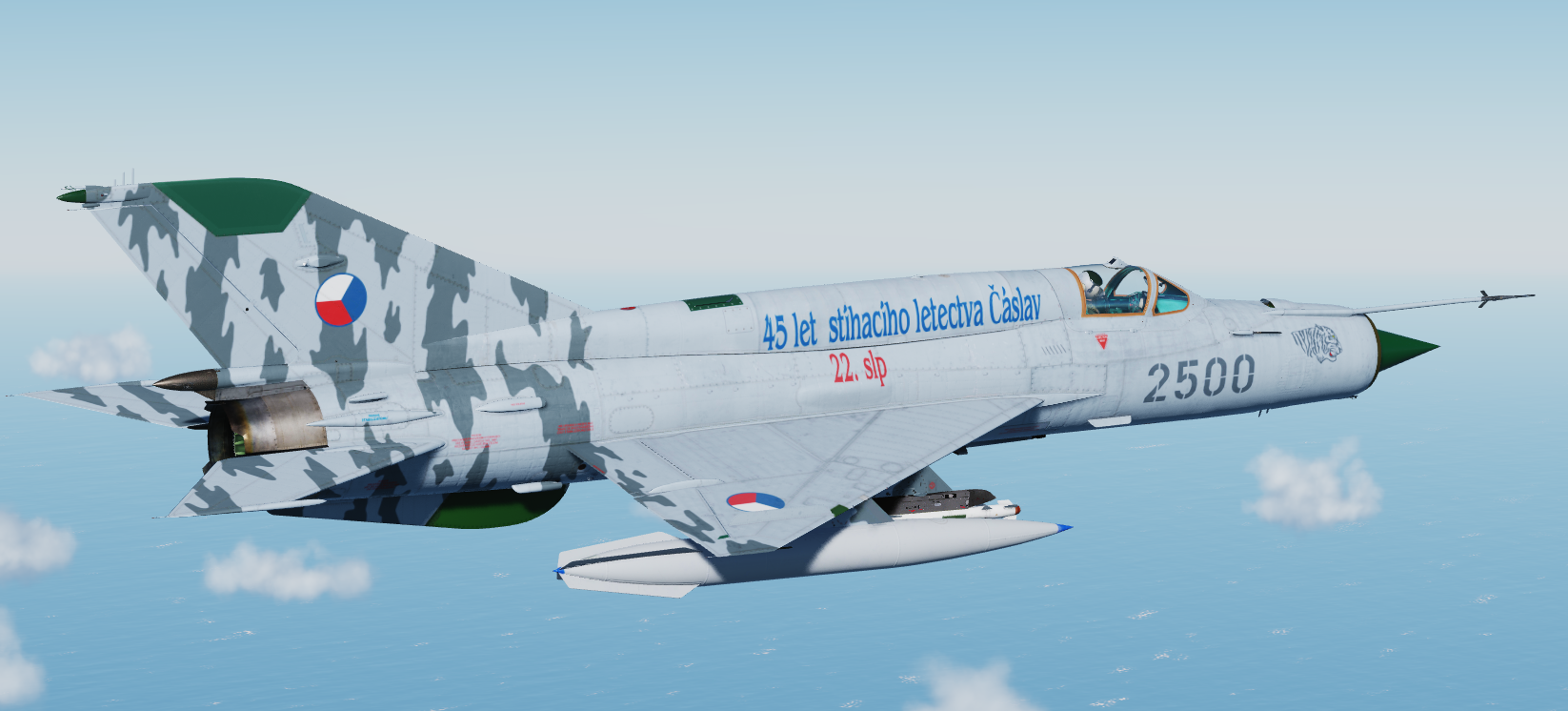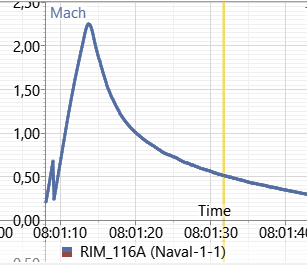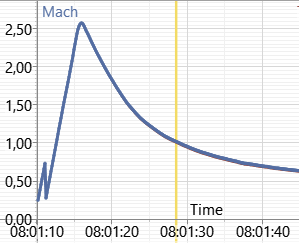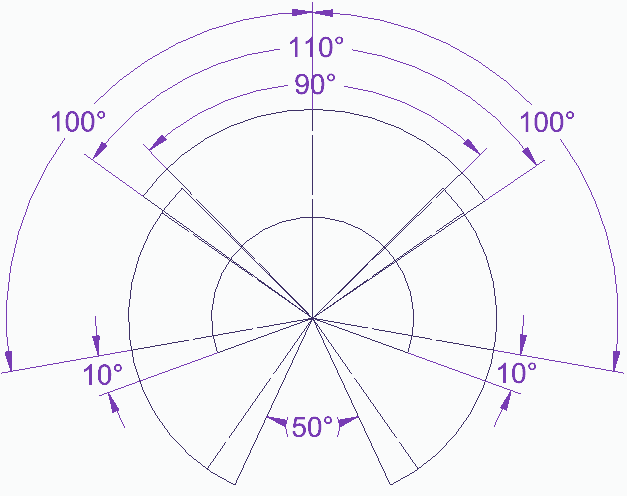-
Posts
858 -
Joined
-
Last visited
Content Type
Profiles
Forums
Events
Everything posted by GumidekCZ
-
I would like to report a BUG, which is connected almost to all missiles in DCS. There is defined max speed for every missile in DCS (you can also read them in DCS Encyclopedia) which are for ideal perfect conditions, where missile fly without any none of un-neccesary maneuver and keep accelerating to less dense air. If missile stais in level flight at low alts, it will never reach its max speed. in this example, missile has its peak around speed in TAS: 4890 km/h which gives us TAS 1358 m/s at altitude of 5247 m. Climb angle of 19° is taken in account in TAS, its not speed vector paralel to Earth surface. When we use NASA calculator in metric units: https://www.grc.nasa.gov/WWW/K-12/rocket/machu.html Result for that alt is than Mach 4.249, which is almost the same what Tacview says (Mach 4,24). As we now, the missile have its max speed "Mach_max = 5," defined in missile script. So there si Mach 0.75 difference (15% less), and that is a lot. I know that some of you starts to argue with me about actual air pressure and temperature... but this will not bring us back that huge amount of extra speed, the missile should have. Some of the missiles have more close speed to its defined max velocity, some of them are even worse than above mentioned 15%. I can follow on with rest of DCS missiles, but it would take very long time to do so. So only one more example without track: SA-6 3M9M missile measured in DCS with max speed Mach 1.9-2.0, in script it defined as Mach 2.2 - which it self is slow when compared to public data of M2.6~2.8 or 900m/s. That not good, really. AIM-120C just quick check with M3.3 measured from M0.98 launched flyght - compare with max speed of Mach 4.0 Do we have is grey slowdown coeficient or am I missing something? _DCS_SLOW_MISSILES.trk
-
AIM_54 all versions: sigma = { 5, 5, 5 }, (all versions: KillDistance = 15,) R-33(AA-9 AMOS): sigma = { 10, 10, 10 }, (KillDistance = 12,) AIM-7E: aim_sigma = 8, (proximity_fuze radius = 12,) AIM-7F: aim_sigma = 5.5, (proximity_fuze radius = 12,) AIM-7M: aim_sigma = 5.5, (proximity_fuze radius = 12,) AIM-7MH, aim_sigma = 5.5, (proximity_fuze radius = 12,) SeaSparrow (RIM-7): aim_sigma = 5.5, (KillDistance = 12,) Super_530D, R-24R, R-27R, R-40R, R-77: sigma = { 5.6, 5, 5.6 }, (530D: KillDistance = 10, R-77: KillDistance = 15, R-27R/ER : KillDistance = 11, R-24R KillDistance = 6, R-40R KillDistance = 7,) R-3R: sigma = { 5, 5, 5 }, (KillDistance = 5,) AIM_120B: aim_sigma = 7, (proximity_fuze radius = 7,) AIM_120C-5: aim_sigma = 6, (proximity_fuze radius = 7,) SD-10: aim_sigma = 7, (proximity_fuze radius = 10,) Now you can see, that even very old A-A radar guided missiles (R-3R, R-24R, R-40R, early AIM-54, AIM-7F and M, have in DCS same Missile final miss distance value as the modern ones. Considering an article in book mentioned in previous post, there is certainly some wrong values.
-
Rapier SAM Blind Fire TR radar and optic tracking device unable to sort targets. Both tracking sensors watching same target when more than one exist inside its WEZ. Because of that, the capability of such system is degraded. If only single target in WEZ - its ok if both tracking same. But in multiple target scenario, there must be better script to sort targets. Now both sensors tracking outbound target, when at the same time there dangerous hot target ingressing. Problem of DCS Rapier not end by this, by continue with script system unable to evaluate Pk of close shots and aspects of targets with its speed. What in case of hostile helicopter may seem be nice feature minRange = 400m - this is very very bad idea against every aircraft flying around. The missile just cant steer so quickly and it just waste of missiles (first 1 second the missile fly just streight in 20° up angle and another sec or two it need to get back on commanded LOS). Missiles at this point often fired in salvo of more than 2 msls. Just very few flybys, and system needs to reload entirely. Together with LOW (another DCS bug) max speed of just M1.86 instead of M2.5 ... the result Pk of fully reloaded system is worse than any other SHORAD SAM system in game. Fix issues mentioned above...and it will very nicely scripted realistic SHORAD system in DCS. RAPIER_BUG.trkTacview-20211005-233414-DCS-RAPIER_BUG.zip.acmi Another acmi files to watch: RAPIER_Pk_only_20.acmi RAPIER_Pk_only_25.acmi SA-19 Tunguska performance for comparism: TUNGUSKA_Pk_100.zip.acmi
-

reported Al Dhafra AFB ILS freq not working
GumidekCZ replied to GumidekCZ's topic in Bugs and Problems
@Flappie - amaizing work, your are a man of action. Hope that somebody will Fix all that after Apachee is completed ****- 20 replies
-
Just recently i searched some DCS scripts and found very strange things, which guide my thoughts to search for more RW evidence about missile final miss distance. I found this book: Basic Principles of Homing Guidance - Neil F. Palumbo, Ross A. Blauwkamp, and Justin M. Lloyd There is an chapter: Contributors to Final Miss Distance Page 33. All points are described in more detail there. So my idea is that accuracy and Missile final miss distance in DCS should NOT be based on just wide spread general number across most/all missiles of its class (with some BUG like missiles SA-5, Stinger, Rapier, Patriot), but the predefined miss should be based on technological level of the producer at the time, the missile was designed or upgraded. Question can be laid, if the radius(diameter) should be placed withing Gauss curve or it should be linear. In addition, I added for each missile its Kill Distance radius (fuze radius for the warhead), so you can now make a picture which missile can go closer to you and which missile have bigger kill radius. Some of the numbers are very disturbing and I will report them as a BUG. SAM: S-75(SA-2) 2V755 missile test 1959: sigma = { 50, 50, 50 }, KillDistance = 20 S-200 VEGA (SA-5 GAMMON) 1967 sigma = { 10.81, 10.81, 10.81 }, - only 10.81m!!! - I will report as a DCS BUG. KillDistance = 45, SM-2: introduced in 1970, sigma = { 50, 50, 50 }, KillDistance = 15 HAWK MIM-23B Introduced in 1971: sigma = { 50, 50, 50 }, KillDistance = 12 S-300PS(SA-10) introduced in 1985, sigma = { 50, 50, 50 }, KillDistance = 20 PATRIOTs PAC-2 was first tested in 1987, sigma = { 50, 50, 50 }, KillDistance = 13 PATRIOT, S-300 systems were designed to also kill other missiles, but with sigma 50 its very unlikely, especialy for PATRIOT with just only 13m kill distance. Another example are IR guided A-A missiles - Almost ALL of them from the oldest (AIM-9B) to the newest (except the AIM-9X), all have the same sigma = { 3, 3, 3 }, I will add one more example of impact fuzed warhead SAM missile later toady. Need to go now
-
Minhad ILS 09 110.70 not working ILS RWY 27 110.75 work like a charm. or from oposite direction as a backtrack but without glideslope. Beacon.lua script seems ok, but Im not an expert Minhad_ILS09_110.70_BUG.trk
-
Hmmm, today I tried to edit the script to see, if the sigma is the source of the problem. What I have found is that there is another wrong thing hidden somewhere id DCS that makes the RIM-116 to miss almost all the time, when it try to intercept antiship missile at level or only shallow climb. In steeper climb, the missile have almost 100% accuracy as can bee seen from this track. I have put Tu-22 in longer distance, so antiship missiles not fly low near the sea surface. And it works. RIM-116_Good.trk Another problem of this missile in DCS is the speed: The max speed noted in DCS and from many sources elsewhere is M2.5 .... but from track ... you can see that only M2.25 is achieved. Missile is around only M1.0 at half of its max range of 10km, because of this: cx_coeff = {1,2.7,0.8,1.36,1.75}, --this is what can be found on simillar type of well scripted DCS missile: cx_coeff = {1,1.5,0.68,0.7,1.75} --also v_mid needs to be increased from 350 to v_mid = 370.0, After engine burnout, the missile now slow down almost with same deceleration as was accelerating. Also I want to add here that if the missile have max range of 10km, than the missile can be launched when antiship missile is not just exact 10km away, but even before it crosses this line. Now in DCS (to much drag): My result with suggested vaules:
-

reported Al Dhafra AFB ILS freq not working
GumidekCZ replied to GumidekCZ's topic in Bugs and Problems
@Flappie I extracted all Dhafra navigation beacon frequencys from BEACON.lua for you. Beacons_DHAFRA.lua- 20 replies
-
@YukinoTora I had also an issue with CTD with no warning at all. I tried to limit amount of virtual memory file to size of my 16GB RAM on WIN system disc and deleted all other page files (also one from DCS SSD disc) - and it helped ... no CTD so far.
-
RIM-116 RAM missile BUG with to high Sigma value still present in OB version. Fuze setting with distance of KillDistance = 5, No wonder that missile do nothing. Simga vaule have very big problems when it comes with frontal intercept - which the RIM is trying to do against antiship missiles. Now: sigma = { 10, 10, 10 }, Should be per Stinger FIM-92 seeker, which the RIM-116 missile have mounted before update it has sigma = { 3, 3, 3 }, now in script abs_err_val = 4, (same as Igla) Than the chances would be much better. And again: aim_sigma = 20, - that is bad, really bad. I compared Lua file, and found that NOTHING was changed since reported. RIM-116_HIGH_SIGMA_VALUE_BUG.trk PLS @Flappie or @BIGNEWY, can you do something about that? Thanks very much in advance.
-

reported Al Dhafra AFB ILS freq not working
GumidekCZ replied to GumidekCZ's topic in Bugs and Problems
Dhafra is broken I guess since release. No-one from ED had even few minutes to just mark it as REPORTED. I found Dhafra bug report which was posted 10th March 2020 - sadly also unnoticed by ED https://forums.eagle.ru/topic/227445-ils-issues-al-dhafra-ab/&ved=2ahUKEwjo4qfyiqfzAhVD-6QKHbagCQ4QFnoECAQQAQ&usg=AOvVaw0IH1EHBbVHDiL6i0uZq9X-- 20 replies
-
- 1
-

-

Patriot STR doesn't work properly
GumidekCZ replied to Lukas2438's topic in Ground AI Bugs (Non-Combined Arms)
Hi @BIGNEWY , me again ,but this time, I will stay short of any source document screens (against the forum rules). The Patriot radar have the ability to rotate to any angle around 360° I suppose, but never to angle to put supporting units into radiation danger (50° example on picture). I studied briefly this document and there much more about adjusting radar azimuth into the threat axis: TM 9-1430-602-10-1 PATRIOT Operators Manual (search for "commnad fp reorientation") My Patriot setup example with course 360° as threat axis - Primary Target Line (PTL): TR 90° -Search zone - correct as in DCS is TR 110° -Tracking zone - correct as in DCS is TR 100° -CW an CCW train azimuth limit for Secondary Target Line (STL) - missing in DCS = BUG TR 50° -Radiation Cut-off zone (no radiation to friendly supporting untis) LN 10° -Launcher able to turn 10° more CW or CCW than both STL. (Launcher azimuth +-110° = 220° in total - correct as it is in DCS) (smallest circle on picture). What I didnt found source for, is if radar was able to adjust its azimuth when in process of missile guidance to target, or if oprators need to wait till no missile guided by radar. I suppose that second option is correct. If needed I will try to put here more evidence material links and references. -
Supercarrier manual: So this is not true anymore? @BIGNEWY do you think this is ok?: Persian Gulf FA-18C Case I Carrier Landing.miz: Carrier WP0: 25kts WP1: 5kts - Carrier slowing down as player try to land. Headwind: 5kts Hornet 1989-OCA.miz Carrier WP0: 18kts WP1: 18kts Headwind: 12kts (20° Starbord side) Result: Carrier with WOD 28 knots, not bad, but wrong carrier course results more starbord wind than desirable for safe landing procedure. NAVAIR 00-80T-104 : 8.4 EXCESSIVE WIND-OVER-DECK OPERATIONS Winds starboard of the angle also adversely affect recovery conditions. The burble, aft of the ramp, becomes stronger and moves closer to the ship as the magnitude of recovery crosswind is increased. The airflow disturbance requires corrective pilot technique if the recovery crosswind exceeds 7 knots for all carriers. Even with corrective pilot technique, sinking speeds 3 to 6 feet per second in excess of those experienced during normal (no recovery crosswind) operations can be expected. For these reasons, recovery headwind should be maintained as closely as possible to the optimum velocity and the centerline of the landing area. Shipboard aircraft recovery operations with recovery crosswinds in excess of those specified should be avoided. Refer to Aircraft Recovery Bulletin No. 10-10. WOD question is now answered to me by reading following document. So I will no more report any slow WOD if not slower than 3 knot for Hornet. NAWCADPAX/TR-2002/71 : 8.2.1 SPEED DEFINITIONS 8.2.2 APPROACH SPEED 4.2.2.2 Performance Capabilities
-
Wind over deck and recover speed would be 25-30 knots in direction of landing axis. Not in BRC direction. I need to say, that I didnt checked the campaign missions, only single and quickstart missions. Persian Gulf FA-18C Case I Carrier Landing.miz: Carrier WP0: 25kts WP1: 5kts Headwind: 5kts Result: Carrier slows down I player try to land with insuficitient WOD. Persian Gulf FA-18 Strike Fighter.miz: Carrier WP0: 11kts WP1: 11kts Headwind: 4kts Result: Carrier with insuficitient WOD 15 knots. FA-18C_IA_PG_Flown the Coop.miz Carrier WP0: 21kts WP1: 21kts !!! TAIL wind: 3kts !!! Result: Carrier with insuficitient WOD 18 knots. FA-18C_IA_PG_Missile City.miz: Carrier WP0: 0kts WP1: 27kts Headwind: 7kts Result: Carrier with WOD Overspeed 34 knots. FA-18C_IA_PG_GOPLAT Defense.miz: Carrier WP0: 17kts WP1: 17kts Headwind: 4kts Result: Carrier with insuficitient WOD 21 knots. FA-18C_MAR_IA_Hot Start.miz same as FA-18C_MAR_IA_Cold Dark.miz same as FA-18C_MAR_IA_Free Flight.miz: Carrier WP0: 17kts WP1: 17kts !!! TAIL wind: 4kts !!! Result: Carrier with insuficitient WOD 13 knots. Caucasus FA-18C Aerial Refueling.miz: Carrier WP0: 11kts WP1: 11kts Headwind: 7kts Result: Carrier with insuficitient WOD 18 knots. C-SUPERCARRIER-HORNET-COLD NIGHT START same as C-SUPERCARRIER-HORNET-COLD START.miz and C-SUPERCARRIER-HORNET-LAUNCH.miz Carrier WP0: 10kts WP1: 11kts Headwind: 15kts (45° port side) Result: Carrier with WOD 24 knots, not bad, but wrong carrier course results more port wind than desirable for safe landing procedure. Caucasus FA-18C Carrier Takeoff.miz Carrier WP0: 11kts WP1: 11kts Headwind: 7kts Result: Carrier with insuficitient WOD 18 knots. Hornet 1989-Alert 5.miz Carrier WP0: 20kts WP1: 11kts Headwind: 5kts Result: Carrier with insuficitient WOD 16 knots. Hornet 1989-CAS.miz: Carrier WP0: 20kts WP1: 11kts Headwind: 12kts Result: Carrier with WOD 23 knots - could be little more, but almost ok. Hornet 1989-OCA.miz Carrier WP0: 18kts WP1: 18kts Headwind: 12kts (20° Starbord side) Result: Carrier with WOD 28 knots, not bad, but wrong carrier course results more starbord wind than desirable for safe landing procedure. Caucasus FA-18C Case III Carrier Final Approach Landing.miz Carrier WP0: 25kts WP1: 11kts Headwind: 5kts Result: Carrier with insuficitient WOD 16 knots. Caucasus FA-18C Carrier Cold Start.miz Carrier WP0: 11kts WP1: 11kts Headwind: 7kts Result: Carrier with insuficitient WOD 18 knots. Caucasus FA-18C Case III Carrier Landing.miz Carrier WP0: 25kts WP1: 11kts Headwind: 5kts Result: Carrier with insuficitient WOD 16 knots.
-
When fighting against low bad guys, you have to think about this current limitation. I hope, that they will improve look down scan radar model as soon as EDs free human resources will be available.
-
DCS 2.7.6.13133 Open Beta I would like to report, that Hronets radar can only follow airborne contact when in STT to its vertical low angle limit of - 60°. When in RWS , TWS (MAN or AUTO), the contact will just dissapear with zero chance of detecting it bellow - 27° When compared with F-16 radar, it behawe same way. Nevada map: APG-73_low_scan_RWS.trkAPG-73_low_scan_TWS.trk Marianas map: APG-73_low_scan_TWS_Marianas.trkAPG-73_low_scan_RWS_LS_Marianas.trkAPG-68_low_scan_RWS_SAM_Marianas.trkAPG-68_low_scan_TWS_Marianas.trk
-
I'm not sure, but according to my calculations and DCS detection measurements the ED is using Signal to Noise Ratio (S/N) which is defined somehow somewhere in DCS together with some detection range cut range for larger RCS aircraft. For Hornet and Viper that is around 77-78nm. Both radars now have very similar S/N ratio. Somebody would like to argue about Hornets radar performance needs to be according to available data 10-20% better. I don't have thrust worthy source of this info. But Vipers radar was smaller, that's for sure. Other hardware and software differences ... I didn't know, but expecting that it also does matter.
-

today's WAGS video about BRA and BULLS and Magnetic vs True
GumidekCZ replied to JEFX's topic in DCS: F/A-18C
As erported here at my last post and can be seen from posted screen, the BRAA is always in TRUE no matter if you switch MAG/TRUE. Now not only BRAA value is not MAG but also radar off centre angle value at AZ/EL page. -

fixed AZ/RL page elevation and azimuth value bug
GumidekCZ replied to GumidekCZ's topic in Bugs and Problems
Ahh, ok, BRAA is NOT affected by seting MAG/TRUE in A/C page...it show always in TRUE. Is this also a bug? -
There is another bug in AZ/EL page other than I already reported (not accurate elevation scan borders - they show more than scan is). Now the bug is about two or three things: 1) radar look angle values on top left corner of AZ/EL page. It shows wrong elevation when radar is in STT lock. When is RWS, TWS(MAN/AUTO), elevation value is correct. On picture you can read 61°D (down), but reality was as radar shows exact 30° down. 2) Azimuth value on top left corner of AZ/EL page shows 23°R (right), but as radar screen (and its azimuth scale marks) show, the target was only like 10° off nose of my Hornet. This error is homehow connected to BRAA value, because as you can easy calculate: 347° - 325° = 22°Right - and thats wrong. 3) Third and less apparent bug is hidden in AZ/EL contact mark, which is not exactly matching 30°down mark as can be seen on radar page, but is approximately 5° up of 30°mark (25°Down from nose). APG-73_low_scan_STT.trk
-

JF-17 AI unit almost twice as much thrust BUG
GumidekCZ replied to GumidekCZ's topic in Aircraft AI Bugs (Non-Combined Arms)
Thanks, didnt know that. Now when compared tables ... its ok. Disregard this topic than. Just if you tell me, why these faulty values I reported are in the Lua and if used, than where are used? -
https://military.wikia.org/wiki/Shenyang_J-11 Russian AL-31F: https://military.wikia.org/wiki/Saturn_AL-31 AL-31F wet thrust 123 kN Chinese WS-10A: https://en.wikipedia.org/wiki/Shenyang_WS-10 Development: A full-scale WS-10A engine was first seen at the 2008 China International Aviation & Aerospace Exhibition. In 2009, Western media claim that the WS-10A approached the performance of the AL-31, but took much longer than the AL-31 to develop thrust. Furthermore, the engine reportedly only generated 110–125 kilonewtons (25,000–28,000 lbf) of thrust. In April 2009, Lin Zuoming, head of AVIC, reported that the engine's quality was unsatisfactory. In 2010, it was reported that reliability was also poor; the WS-10A lasted only 30 hours, while the AL-31 needed refurbishing after 400 hours. The quality problems encountered with the WS-10A reflected the state of the Chinese aerospace industry. AVIC initiated a general effort to improve quality control throughout its production chain in 2011. The WS-10A reportedly matured enough after 2009 to power the J-11B Block 02 aircraft.
-
Searching for any doc about it, but in mean time found this in J-11A.Lua script: thrust_sum_max = 15200, -- J-11A 51.2 kN thrust_sum_ab = 25000, -- J-11A 84.6 kN Why the devs put note there with only 1/3 of thrust - assuming been meaned for single engine. Did the J-11A version used weaker export version of engines, or some kind of Chineese weak copy? The values suits to Klimov RD-93 turbofan engines. Weird thing is that same values at note was found at JF-17.Lua script, that plane is using RD-93 engines. - But AI unit have wrong thrust values for AI JF-17 - I made Bug report about it:







